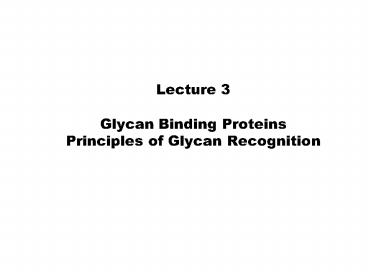Lecture 3 Glycan Binding Proteins Principles of Glycan Recognition - PowerPoint PPT Presentation
1 / 26
Title: Lecture 3 Glycan Binding Proteins Principles of Glycan Recognition
1
Lecture 3Glycan Binding ProteinsPrinciples of
Glycan Recognition
2
The Glycome is Rich
3
GBPs to Translate the Glycome
Soluble Glycan-Binding Proteins
4
Two Classes of GBPs - Lectins and GAG Binding
Proteins
5
(No Transcript)
6
Mannose Binding Protein (C-type lectin)
- Mannose binding protein is trimeric and each
subunit binds to mannose - Notice that binding occurs in shallow pockets
near the surface
7
Cholera Toxin
- Cholera toxin exists as a AB5 complex, each B
subunit binds to a single molecule of GM1 - The glycan binds to shallow pockets near the
surface
8
Flu Hemagglutinin
B
9
?-mannose in the CRD of FimH
10
?1-4Galactosyltransferase
Van der Waals surface diagram around the
trisaccharide GlcNAc?1-2Man?1-6Man
11
Link Module - Hyaluronan Binding
12
Flavivirus Adhesin
Heparan sulfate interacts with protein across a
groove lined with positive amino acids (Lys Arg)
13
Cholera Toxin
- Cholera toxin exists as a AB5 complex, each B
subunit binds to a single molecule of GM1 - The glycan binds to shallow pockets near the
surface - Kd of monomer for GM1 40 nM, very unusual
(usually µM to mM)
14
Cholera Toxin
- Multivalency raises affinity of interaction to
40 pM
15
- Only 3 sugars are bound
- Selectivity is high, since binding occurs with
great precision
- Electrostatics
- H-bonding
- van der waals interactions
- Tyr, Phe, or alkyl side chains
- Water and divalent cations can act as bridging
groups that increase selectivity
16
Cholera Toxin
- Multivalency raises affinity of interaction to
40 pM - Notice that many lectins are multimeric
17
- High Avidity can also result from coopretive
interactions at independent sites - Whats the advantages/disadvantages of
multivalency?
18
What is meant by affinity?
19
Equilibrium-Dialysis
G
L
Set up dialysis and allow equilibrium to occur
(days). Measure G in both chambers
20
Leq
Keq LGeq / LeqGeq
Geq
LGeq
Leq Linit - LGeq
LGeq Gtotal in left compartment - Gright
Written this way Keq Ka (units M-1)
1/ Ka Kd (units M)
21
ITC titration profile (top panel) of SBA (a
lectin) titrated with Tn-PSM (a mucin). The lower
panel shows a fit of the binding data
Dam, T. K. et al. J. Biol. Chem.
200728228256-28263
22
peptide repeats
2300 glycans
23 glycans
11-12 glycans
Dam, T. K. et al. J. Biol. Chem.
200728228256-28263
23
From Table 1. Hemagglutination inhibition data
for SBA Ligand Kd K(rel) GalNAc?1-O-Ser
1000 1 38/40-mer Tn-PSM 5.6 180 81-mer
Tn-PSM 0.15 7000 Tn-PSM 0.0003 3,000,000
From Table 2. Thermodynamic binding parameters
for SBA Kd K(rel) ?G ?H T?S n µM
(kcal/mol) GalNAc?1-O-Ser 170 1 5.2
7.9 2.7 1.0 38/40-mer Tn-PSM 1.4 120 8.0
32.2 24.2 0.2 81-mer Tn-PSM 0.06 2,800 9.8
56.1 46.3 0.12 Tn-PSM 0.0002 850,000 13.1
4310 4297 0.0018
24
(No Transcript)
25
Questions to Ponder
- 1. What is a lectin? What is a CRD?
- 2. Why are sulfated GAG binding proteins
distinguished from lectins? - 3. What determines the binding affinity of a
glycan for a GBP? - 4. What are the advantages and disadvantages of
achieving high affinity through multivalency? - 5. How does the density of carbohydrate ligands
affect binding of a GBP? Is this relevant in
vivo? - 6. Would you predict the existence of GBPs that
bind to the tips of GAG chains? What would be
the advantages and disadvantages of this binding
mode?
26
FGF-FGFR Heparin































